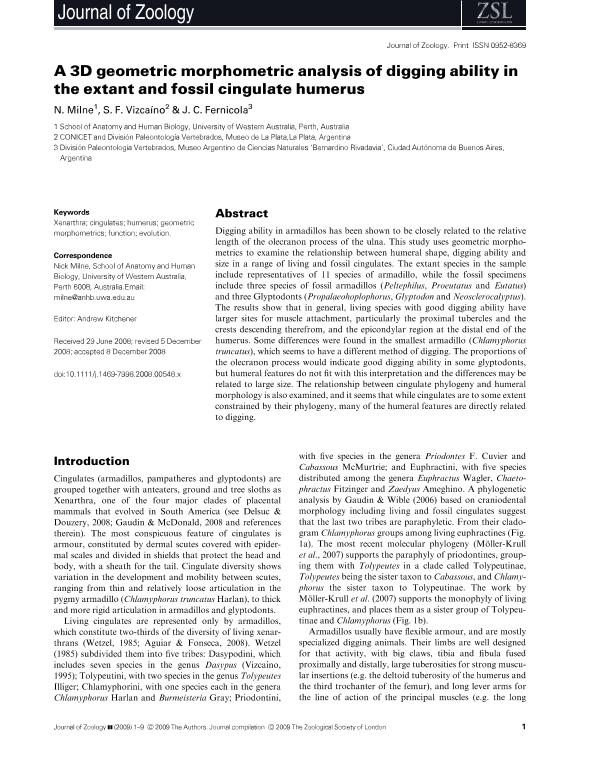Artículo
A 3D geometric morphometric analysis of digging ability in the extant and fossil cingulate humerus
Fecha de publicación:
05/2009
Editorial:
Wiley Blackwell Publishing, Inc
Revista:
Journal Of Zoology
ISSN:
0952-8369
e-ISSN:
1469-7998
Idioma:
Inglés
Tipo de recurso:
Artículo publicado
Clasificación temática:
Resumen
Digging ability in armadillos has been shown to be closely related to the relative length of the olecranon process of the ulna. This study uses geometric morphometrics to examine the relationship between humeral shape, digging ability and size in a range of living and fossil cingulates. The extant species in the sample include representatives of 11 species of armadillo, while the fossil specimens include three species of fossil armadillos (Peltephilus, Proeutatus and Eutatus) and three Glyptodonts (Propalaeohoplophorus, Glyptodon and Neosclerocalyptus). The results show that in general, living species with good digging ability have larger sites for muscle attachment, particularly the proximal tubercles and the crests descending therefrom, and the epicondylar region at the distal end of the humerus. Some differences were found in the smallest armadillo (Chlamyphorus truncatus), which seems to have a different method of digging. The proportions of the olecranon process would indicate good digging ability in some glyptodonts, but humeral features do not fit with this interpretation and the differences may be related to large size. The relationship between cingulate phylogeny and humeral morphology is also examined, and it seems that while cingulates are to some extent constrained by their phylogeny, many of the humeral features are directly related to digging.
Palabras clave:
CINGULATES
,
EVOLUTION
,
FUNCTION
,
GEOMETRIC MORPHOMETRICS
,
HUMERUS
,
XENARTHRA
Archivos asociados
Licencia
Identificadores
Colecciones
Articulos(CCT - LA PLATA)
Articulos de CTRO.CIENTIFICO TECNOL.CONICET - LA PLATA
Articulos de CTRO.CIENTIFICO TECNOL.CONICET - LA PLATA
Citación
Milne, Natalia Romina; Vizcaíno, Sergio Fabián; Fernicola, Juan Carlos; A 3D geometric morphometric analysis of digging ability in the extant and fossil cingulate humerus; Wiley Blackwell Publishing, Inc; Journal Of Zoology; 278; 1; 5-2009; 48-56
Compartir
Altmétricas




